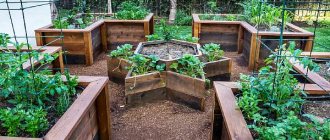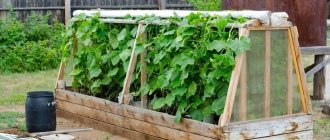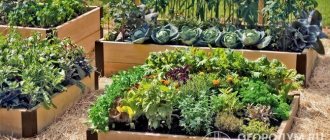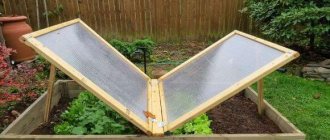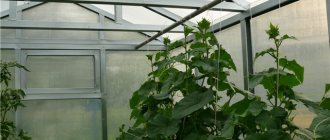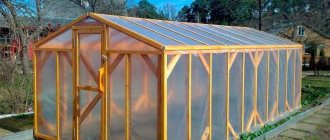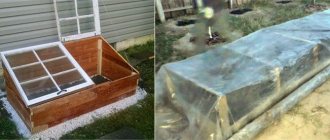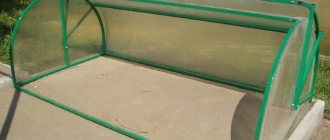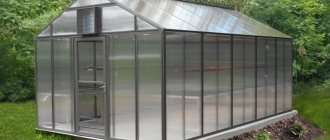Cucumbers are capricious plants, demanding heat and requiring high air humidity. In our “risky farming” zone, it is very difficult to provide them with such conditions in the open ground. Therefore, any gardener wants to know how to make borage in the country with their own hands. But if a small greenhouse is enough for one to shelter young plants until the onset of stable heat, then the other wants to have a full-fledged greenhouse and grow cucumbers in it throughout the summer season. Any design can be made independently. Read the article and choose the best option for yourself.
Growing cucumbers in a greenhouse allows you to increase their yield Source 7ogorod.ru
Features of cucumber greenhouses
It’s not for nothing that experienced summer residents try not to plant cucumbers and tomatoes in the same greenhouse - they need different conditions for normal vegetation and fruiting. Therefore, when deciding how to build a greenhouse for cucumbers, it is necessary to take into account the peculiarities of their agricultural technology.
- Square.
Plants are very demanding on the composition and nutritional value of the soil, good lighting, so each of them needs a lot of space. This means that the shelter must be spacious enough. The area depends on the number of bushes planted.
- Height.
The fruits are tied on long vines, which must be tied in a vertical position. The height of the greenhouse should allow this to be done. As a rule, borage plants are built no lower than 1.5-1.7 meters. In addition, the design provides for the possibility of installing supports or attaching twine and netting.
Garter of cucumbers in a greenhouse Source homeli.ru
- Ventilation and sun protection.
A sharp change in temperature is detrimental to these plants, so before you make a greenhouse for cucumbers with your own hands, you need to think about a way to ventilate and shelter the plants from scorching rays on sunny days.
- Watering.
Coming from tropical countries, cucumber loves not only warmth, but also high humidity in the air and soil. To prevent them from drying out, it is advisable to equip the greenhouse with automatic watering. Especially if you only appear at the dacha on weekends.
Advice! The ideal solution would be to automate all systems - lighting, ventilation, humidity control, etc. But this is profitable only for large volumes of growing vegetables in permanent greenhouses.
Automatic windows maintain optimal humidity and temperature in the shelter Source vasha-teplitsa.ru
Principle of operation
The name “warm bed” speaks for itself - it should warm. Not all gardeners know what and how to keep warm. The process is based on organic and physical reactions. The dacha is full of all kinds of plant waste:
- mown grass;
- weeds;
- food waste;
- dry leaves;
- waste paper;
- branches and bark of trees and shrubs.
This unnecessary garbage will serve as a good basis for a warm garden bed. When organic matter overheats, it releases a lot of heat, warming the soil. And the decomposed substances turn into valuable fertilizer - humus.
The “insulating” material needs to be laid out in the place of the future cucumber bed. The bottom layer should consist of large coarse fragments: branches, thick stems, bark. This is a kind of drainage that ensures air circulation. The next layers will be made up of smaller organic matter: foliage, grass, weeds, food waste. When laying out layers, it is advisable to water them in order to increase the moisture content of the organic material, and therefore set in motion the process of fermentation and decomposition. This chemical reaction will create the heat needed to grow the crop.
Raw materials affected by rot and disease cannot be used, as they can become a source of disease not only for the leaves, but also for the fruits of cucumbers.
The “stuffing” for warm beds can be prepared in advance. To do this, you need to set aside (fence off) a certain place on your personal plot, where various dacha waste will gradually be deposited.
Buy or build
Today you don’t have to think about how to build a borage garden with your own hands, but simply buy a ready-made prefabricated structure. There are options for sale in any size and shape, from different materials. In addition, you can order production and assembly on site. There would be money.
It is the high cost of such products that most often forces summer residents to start constructing greenhouses on their own. Or the inability to select a design with the required parameters among the finished products.
Homemade greenhouses are primarily about saving money, since you can use existing materials left over from building a house and other buildings. Their shape, size and equipment will meet the owner’s needs. But implementing such an idea is much more difficult, because it will require design calculations, selection of materials and, of course, certain labor costs.
The finished greenhouse is easily assembled from individual elements according to the instructions Source gardeck.ru
If these difficulties do not scare you, and you want to figure out how to build a greenhouse for cucumbers with your own hands, this article will help you understand all the nuances of manufacturing and decide on the design.
Selection of materials
What to make a greenhouse from depends on many factors:
- requirements for material durability;
- ease of processing and assembly;
- the need or unnecessaryness of additional processing;
- resistance to the microclimate of the greenhouse and the ability to provide the necessary conditions inside it.
Price is also important. Therefore, if the owner of a summer house already has suitable materials, he tries to come up with a design that allows them to be used to the maximum.
Frame
The borage frame can be made of wood, plastic pipes or metal profiles. Each material has its own advantages and disadvantages.
- Tree.
The material is easy to process, does not require complex tools for installation and is relatively inexpensive. A big plus is low thermal conductivity, the frame does not heat up from the sun. But it is not durable, so it requires impregnation with special means to protect it from rotting, fire and damage by insects.
Greenhouse on a wooden frame Source cdn.lifehacker.ru
- Plastic.
Plastic and metal-plastic water pipes of small diameter are an ideal material for arched structures, since it is easiest to make a small greenhouse for cucumbers from them. They bend easily without any tools and allow you to create a frame without a permanent foundation. In addition, plastic does not deteriorate from humidity and temperature changes and does not require processing.
Such a temporary greenhouse for cucumber seedlings can be assembled in half an hour Source vasha-teplitsa.ru
- Metal.
A steel profile, round or profile pipe is the strongest, most reliable and durable material for a frame, especially if it is made of galvanized steel or painted with weather-resistant paint. Withstands heavy loads, which makes it possible to make large greenhouses from it. But installation requires special skills in working with metal and expensive tools for cutting, welding, bending, and grinding.
To make an arch, you need a pipe bender Source teplica-exp.ru
See also: Contacts of companies that specialize in the construction of greenhouses.
Covering material
The frame is covered with film, agro-fabric, glass or cellular polycarbonate.
- Polyethylene film.
Used for temporary seasonal greenhouses as the most budget-friendly material. The main advantages are affordable price, ease of installation, good light transmission properties. But ordinary film has a rather unpleasant quality - condensation accumulates on it, the fall of which on plants can harm them. There are higher quality and stronger stabilized films on sale that do not have this disadvantage. Some of them can withstand up to 3 seasons without being dismantled for the winter.
Reinforced film is stronger than regular film and can be repaired Source teplica-exp.ru
- Agrofibre.
Unlike film, this material allows not only light to pass through, but also air and water. Condensation does not form on it. However, its strength is low; it is not suitable for solving such a problem as making a greenhouse for cucumbers and is only suitable for creating temporary shelters and protecting plants from the sun.
Spunbond - non-woven covering material Source opt-863035.ssl.1c-bitrix-cdn.ru
- Glass.
The most expensive and not the most convenient material: heavy, fragile, not flexible. Today it is not purposefully used for the construction of household greenhouses, but if a lot of old window frames have accumulated on the farm (for example, when replacing them in a house with plastic double-glazed windows), then this is a great way to save money. Glass in wooden frames requires a minimum amount of additional materials for the manufacture of the frame.
Greenhouse made from window frames Source maja-dacha.ru
- Cellular polycarbonate.
The most suitable shelter for permanent greenhouses designed for long term use or winter use. The air enclosed in the cells of the material is a good heat insulator, and it itself is quite resistant to mechanical damage. At the same time, polycarbonate, being essentially plastic, is not afraid of moisture. It is easy to cut with a sharp knife and bends well, so any home craftsman can cope with such a task as making a greenhouse for cucumbers from polycarbonate with his own hands.
Base
Not all cucumber shelters require a foundation. Its device is justified in cases where a capital heated greenhouse or wooden structure is being built. In the first case, the foundation increases the thermal insulation of the structure, and in the second it also protects the tree from contact with wet soil and extends its service life.
Such a foundation is made as a strip foundation by pouring a shallow concrete strip around the entire perimeter or laying it out of brick or building blocks.
A lightweight version - a wooden base on a columnar foundation Source teplica-exp.ru
Temporary, small or mobile greenhouses do not require a permanent foundation. To ensure their stability, other methods are used: deepening vertical load-bearing posts into the ground, attaching them to a frame laid on the ground and, in the case of film coverings, pressing the covering material along the perimeter of the structure with boards, bricks, and earth.
Not the most convenient, but the most budget-friendly design Source teplica-exp.ru
Useful tips
It is advisable to replace the soil every season. The soil must be removed to the depth of a spade bayonet. This amount of fresh soil will significantly increase the chances of getting a good harvest.
Manure with an admixture of straw, peat humus, and compost have proven themselves to be excellent soils. Freshly cut grass laid at the bottom of the bed also helps to increase the yield of cucumbers. Over a long period of time, green grass, like manure, will burn down and release additional nutrients.
It is most practical to equip greenhouse paths with wooden boards. Before laying, they must be treated with antifungal and anti-putrefactive drugs. If this is not done, in the near future the boards themselves will become a source of disease for cucumbers and a haven for insect pests.
In order not to compact the greenhouse soil, you can not cover the entire area of the paths, but use portable wide but short boards.
If you don’t want to build a full-size greenhouse, there is an option to make do with a mini-greenhouse made from scrap materials. All you need is a plastic or metal barrel and a few five-liter plastic bottles.
Technology for arranging a mini-greenhouse:
a barrel or any other container of suitable size is filled to about half with ash, dried grass or leaves;- the contents are compacted. The easiest way to do this is with your own feet;
- about a quarter of the volume of humus or compost is added;
- the resulting “pie” is covered with 10-15 cm of earth;
- cucumber sprouts are planted;
- The bottoms of five-liter bottles are cut off and the lids are removed, after which they are used to cover the seedlings.
The moisture will evaporate much more slowly, and the seedlings will receive much more heat.
In general, tall greenhouses, 2 m or more, are best suited for growing cucumbers. In this case, the internal volume should be as large as possible. Ventilation must be arranged in such a way that superheated air can freely escape into the street without creating a draft.
Types of structures and recommendations for manufacturing
We offer you several options for shelters for cucumbers, from the simplest to the most extensive. During their construction, different materials and installation technologies are used, so you can choose the most optimal one that meets your requirements in terms of cost, service life, and manufacturing complexity.
Film greenhouse made of PVC pipes
This is a budget option for borage, intended for seasonal use and protecting plants from frost, bright sun and dew. It is easy to assemble in a couple of hours and just as easy to dismantle for the winter or move to another place:
- In the selected area, the perimeter of the greenhouse is marked.
- In the corners and long sides, every 100 cm, reinforcement pins 60-70 cm long are driven into the ground so that 20-25 cm remain above the surface.
- Polypropylene or polyvinyl chloride pipes are bent into an arc and placed at the ends on pins, forming a series of arches.
- Using strong twine, the arcs are tied to each other, and its free ends are stretched and tied to pins driven into the ground along the axis of the structure.
To make the earth warm up faster, it is covered with black film Source oteplicah.com
On a note! Before you build a borage plant with your own hands, you need to decide on the length of the pipes. It is selected so that, given the existing width of the greenhouse, its height is at least 150 cm. Temporary shelter to protect seedlings from return frosts may not be high.
Covering the frame with film or spunbond is possible in different ways:
- The canvas is cut to a large margin in length and width, thrown over the arches and pressed against the sides with boards. The ends of the film on both sides are collected and secured to twine pins.
- The ends of the greenhouse are covered with pieces of film, which is stretched and attached to the outer arcs, and the main fabric is cut along the length of the structure, thrown over it and wound on long slats on both sides.
You can secure the film to the arcs with special clamps, paper pins, or pieces of a watering hose cut lengthwise.
Benefits of growing
Cucumbers are quite capricious ; they are grown in open ground only in regions with a very warm and humid climate. A properly selected greenhouse guarantees:
- ideal temperature and humidity, which can be adjusted at will;
- the possibility of growing valuable, rare, especially capricious varieties;
- optimal conditions for the development of seedlings and adult plants:
- extension of the fruiting season until frost;
- the possibility of obtaining the earliest possible harvest;
- ripening of fruits for collecting seeds.
Video description
The production of such a greenhouse is shown in the following video. Pay attention to how you can fasten the arcs together using fittings for plastic pipes:
Advice! If you attach a plastic mesh with a large cell to the frame under the film, you can tie cucumber lashes to it.
Wooden borage hut
The easiest way to build a greenhouse for cucumbers with your own hands from wood is to build a structure from triangular trusses in the form of a hut. Even a woman who knows how to hold a hammer or screwdriver can handle this.
The main material is bars with a cross section of 40x40 mm or 30x50 mm, 2.5-3 m long, depending on the desired width and height of the frame. You will also need several slats and two boards along the length of the structure.
It is convenient to make such a greenhouse in high beds with wooden sides. On them, opposite each other, the places for attaching the trusses are marked, the distance between which should preferably be no more than 150 cm. Then the two bars are knocked together at the upper ends, and the lower ones are nailed or screwed to the sides with self-tapping screws. The upper connection is strengthened by a longitudinal rail passing through all the trusses.
Greenhouse hut on a wooden frame Source www.ogorod.ru
Video description
How to pour a concrete strip is described in the video:
To make it, fertile soil is removed in a strip of 15-20 cm along the perimeter of the future greenhouse, sand is poured into the resulting trench, compacted and a cushion of crushed stone or gravel is laid on top. Then the formwork is installed and concrete mortar is poured into it or masonry is made from concrete blocks.
Before making a greenhouse for cucumbers from window frames, the concrete must be given time to gain strength - 7-14 days, depending on the weather and air temperature. At this time, the tape is covered with film. While the foundation is drying, prepare the frames:
- remove glass from them;
- clean the frames of old paint and, if necessary, repair them;
- impregnate the wood with an antiseptic and dry it;
- Apply fresh exterior paint in two layers.
It is advisable to use frames of the same height. If this is not possible, they are laid out on the ground, selected by shape and size in order to determine the height of the walls and the distance between the frame posts.
Frames of the same width are placed one above the other Source grounde.ru
The greenhouse is assembled in the following order:
- the foundation tape is covered with two layers of roofing material;
- the lower strapping beam is attached to it with anchors;
- corner posts are installed on the harness, using dowels and metal corners for fixation;
- Intermediate ones are installed between the corner posts, the distance between which should correspond to the width of the frames;
- all racks are fastened with top trim;
- in the middle of the end beams of the trim, vertical posts are installed, to which the ridge girder is attached;
- rafters are laid and fixed onto the ridge girder and longitudinal beams of the upper trim;
- roof slopes are covered with cellular polycarbonate or reinforced film;
- window frames and the door to the greenhouse are secured between the posts, foaming all the gaps between the wooden elements;
- inserted into glass frames and secured with glazing beads.
A greenhouse made using this technology will last for decades. But you can simplify the process and significantly reduce the construction budget if you do not make a foundation and abandon the frame, simply fastening the frames together and the frame.
Briefly about the main thing
Homemade greenhouses in the country are more common than ready-made ones, since making a greenhouse for cucumbers with your own hands is much cheaper. To do this, you can use boards, window frames, leftover plastic pipes and other materials available on the farm, and cover the frame with cheap film or spunbond. The easiest way is to build a shelter from flexible pipes, installing arcs on the bed, or from wooden blocks, connecting them in pairs with a hut. Film coating is simple and inexpensive. If you want to build a permanent greenhouse, you need to build a reliable foundation and install old frames with glass or a metal frame covered with polycarbonate on it.
Nuances worth knowing
Today every person knows how a simple polyethylene film shelter works. It would seem that what is so difficult here is to build a greenhouse for cucumbers.
But there are several important nuances in this matter:
- The minimum height for them is considered to be 1.5 m. This value allows you to tie up the lashes (additionally, special fasteners for ropes are required);
- This vegetable crop does not tolerate temperature fluctuations. Therefore, it is necessary to organize a ventilation system and provide protection from direct solar radiation.
- Cucumbers need space because they have a fairly high need for nutrients.
- It is necessary to provide free access for insects to pollinate plants.

